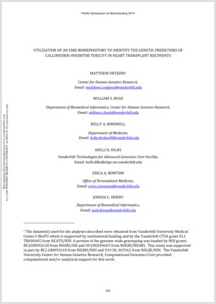Oetjens M, Bush WS, Birdwell KA, Dilks HH, Bowton EA, Denny JC, Wilke RA, Roden DM, Crawford DC,.
Calcineurin-inhibitors CI are immunosuppressive agents prescribed to patients after solid organ transplant to prevent rejection. Although these drugs have been transformative for allograft survival, long-term use is complicated by side effects including nephrotoxicity. Given the narrow therapeutic index of CI, therapeutic drug monitoring is used to prevent acute rejection from underdosing and acute toxicity from overdosing, but drug monitoring does not alleviate long-term side effects. Patients on calcineurin-inhibitors for long periods almost universally experience declines in renal function, and a subpopulation of transplant recipients ultimately develop chronic kidney disease that may progress to end stage renal disease attributable to calcineurin inhibitor toxicity (CNIT). Pharmacogenomics has the potential to identify patients who are at high risk for developing advanced chronic kidney disease caused by CNIT and providing them with existing alternate immunosuppressive therapy. In this study we utilized BioVU, Vanderbilt University Medical Center’s DNA biorepository linked to de-identified electronic medical records to identify a cohort of 115 heart transplant recipients prescribed calcineurin-inhibitors to identify genetic risk factors for CNIT We identified 37 cases of nephrotoxicity in our cohort, defining nephrotoxicity as a monthly median estimated glomerular filtration rate (eGFR)30 mL/min/1.73 m2 at least six months post-transplant for at least three consecutive months. All heart transplant patients were genotyped on the Illumina ADME Core Panel, a pharmacogenomic genotyping platform that assays 184 variants across 34 genes. In Cox regression analysis adjusting for age at transplant, pre-transplant chronic kidney disease, pre-transplant diabetes, and the three most significant principal components (PCAs), we did not identify any markers that met our multiple-testing threshold. As a secondary analysis we also modeled post-transplant eGFR directly with linear mixed models adjusted for age at transplant, cyclosporine use, median BMI, and the three most significant principal components. While no SNPs met our threshold for significance, a SNP previously identified in genetic studies of the dosing of tacrolimus CYP34A rs776746, replicated in an adjusted analysis at an uncorrected p-value of 0.02 (coeff(S.E.)14.60(6.41)). While larger independent studies will be required to further validate this finding, this study underscores the EMRs usefulness as a resource for longitudinal pharmacogenetic study designs.

